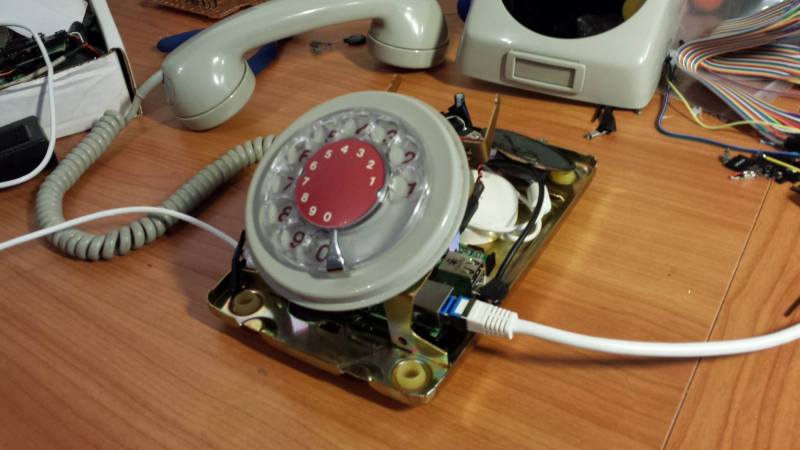There’s something so nostalgic about the rotary phone that makes it a fun thing to hack and modernize. [Voidon] put his skills to the test and converted one to VoIP using a Raspberry Pi. He used the RasPi’s GPIO pins to read pulses from the rotary dial – a functional dial is always a welcome feature in rotary phone hacks. An old USB sound card was perfect for the microphone and handset audio.
As with any build, there were unexpected size issues that needed to be worked around. While the RasPi fit inside the case well, there was no room for the USB power jack or an ethernet cable, let alone a USB power bank for portability. The power bank idea was scrapped. [voidon] soldered the power cord to the RasPi before the polyfuse to preserve the surge protection, used a mini-USB wifi dongle, and soldered a new USB connector to the sound card. [Voidon] also couldn’t get the phone’s original ringer to work, so he used the Raspberry Pi’s internal sound card to play ringtones.
The VoIP (SIP) was managed by some Python scripting, available at GitHub. [voidon] has some experience in using Asterisk at his day job, so it will be interesting to see if he incorporates it in the future.
[via Reddit]















Only cool when wireless and battery powered, Something like a phone you can carry around with you everywhere you go. Oh, wait…
Why? Have you ever used a rotary phone? You want to have a certain weight so that the phone stays in place as you turn the dial. I think this works best as a device that stays put, somewhere in your livingroom as a conversation piece.
ahaaa …”conversation piece”
Nicely done.
The joke passed right through you.
Thus was born the term Neutrino Joke.
No surprise about the ringer. Ring signal is fairly high voltage (60V to 100V, IIRC?)
Many years ago I tried to make a phone ring by pressing a button, for an amateur theater. I tried several old rotary phones and all of them rang with a 12V AC transformer.
Got that right, I’ve shaken hands with it more than once punching down lines on 66 blocks when a call was coming in! Could always use a boost converter but need quite a bit of current to drive those old bell coils.
90V, 20Hz sine wave for the ringer. When the line is picked up, the 48V idle drops to around 12V.
I built a ringer system for a production of “Sorry, Wrong Number” where a number of old style phones had to ring on stage. I was just out of high school, and got them to work with 120VAC. they worked great, but I had to put in a number of safety features so the kids didn’t get shocked.
Just installed a VOIP phone system at work for calls on the air….so if I was going for kitsch…I’d do this too.
A guy from Microsoft said at Redmond (and probably their other sites too) they completely got rid of normal phones and replaced it all with VOIP and Lync.
Two back-to-back center-tap filament transformers will do it, and isolate quite well. use half of the first secondary (~= 3V) and connect it to all of the second secondary (6.3V in for 120V out, but 3V in gives 60V out). Voila! 60V AC on the output primary, completely isolated from line.
I saw somewhere on the web that someone did this with an arduino and a GSM module to make a old phone cellphone that did drive the ringer bell.
I’ve made something similar some time ago. :)
http://hackaday.io/project/2933-retro-gsm
:)
This would be cool to do with a pay phone, you would have to figure out a way to detect the coins, but hey you’ed have much more room in the phone for guts.
Nice one :) Just like mine, which is for PC http://www.ivancreations.com/2014/07/usb-rotary-phone-that-really-works.html
That’s really funny :D But seriously, Raspberry Pi can be used for VoIP telephony purposes without using any rotary phone as well. Check this instructable: http://www.instructables.com/id/How-to-make-VoIP-calls-from-Raspberry-Pi/ This solution is based on this VoIP SDK: http://www.voip-sip-sdk.com
I want a project that uses a raspberry pi as a server and other raspberry pi connect each to a keypad and a headphone to make a secret telecommunication network without using ip phones
I want to make myself an ip phone on my raspberry pi
it’s a project close to your project but I would like more information to do this project for my university please